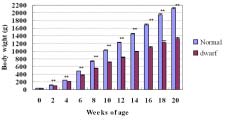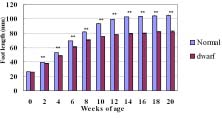THE EFFECT OF SEX-LINKED DWARF GENE ON MUSCLE GROWTH OF CHICKENS
C. S. Chang1, Y. H. Chen1, C. F. Chen1, M. Tixier-Boichard2, and Y. P. Lee1*
1 Department of Animal Science, National Chung-Hsing University, Taichung 40227, Taiwan
2 UMR Animal Genetics and Biodiversity, INRA/INA P-G, Institut National de la Recherché Agronomique, 78352 Jouy-en-Josas Cedex, France
* Corresponding author, e-mail:yplee@dragon.nchu.edu.tw
ABSTRACT
The purpose of this study was to study the effects of the sex-linked dwarf gene on growth. Chickens studied were 251 normal and 207 dwarf pullets from mating of heterozygote males (Dw+/dw) with normal females (Dw+/-) of Taiwan Country chicken. The effect of dwarf gene on chicken’s body weight and shank length was highly significant from 2 weeks of age. The reduction of body weight by the dwarf gene reached 30 and 37.4% of normal chickens at 10 and 20 weeks of age respectively. The significant effect of dwarf gene on single muscle fiber cross-section area of dwarf chickens was found from 12 weeks of age. However, dwarf gene had no effect on the total number of muscle fibers. Comparing the effects of dwarf gene on different carcass traits at different ages revealed that the sex-linked dwarf gene had more influence on skeleton than muscle before 8 weeks of age, and the main influence on muscle growth was from 8 to 12 weeks of age.
KEY WORDS: Age, Muscle growth, Sex-linked dwarf gene.
INTRODUCTION
Selection for heavy body weight was the method employed by the broiler breeding companies to improve the production efficiency of chickens. Although the body size and the production efficiency were improved, it also resulted in a lower reproductive performance (Smith and Fletcher, 1988). Furthermore, the bird became more susceptible to stress, which would be harmful to the meat quality (Debut et al., 2003). It is well known that the sex-linked dwarf gene can reduce the body size of chicken by 30-40% (Hutt, 1959; Mérat, 1984). It is widely used by the broiler breeder to reduce the body size of dam lines in order to improve their reproduction and the efficiency of the production of normal broiler chicks (Mérat, 1984). The sex-linked dwarf gene is also used in some dam lines for the production of ‘Label rouge’ slow-growing broilers in France. The objectives of this study were to compare normal and dwarf pullets during the growing period in the background of Taiwan Country Chicken, which is a slow-growing broiler, with high quality meat.
MATERIALS AND METHODS
Birds
The parental generation used sex-linked dwarf male chickens from a strain developed at the Institut National de la Recherche Agronomique (INRA) and selected for a high clutch length, these males were mated with normal female chickens from National Chung-Hsing University L2 strain (Figure 1). This mating produced an F1 generation consisting in dwarf females and heterozygote normal males that were backcrossed to L2 normal females. In F2 generation, there were homozygote normal males (Dw+/Dw+), heterozygote normal males (Dw+/dw), normal female (Dw+/-) and dwarf female (dw/-). Totally, this experiment used 251 normal and 207 dwarf pullets from the F2 generation. The birds were weighed and shank length was measured every two weeks from birth to twenty weeks to determine the growth rate.
Genotyping
In order to be sure of the dwarf genotype of young chicks, a molecular diagnostic test was performed to identify the genotype of the birds. Blood was collected from F2 pullets and extracted genomic DNA prepared for polymerase chain reaction (PCR). Primer set GHR-B: 5’-TTG TTC ACT CTC CAC AAG GC-3’ and GHR-C: 5’- GAT TCT CCT GGC AGA ATC TC-3’ was designed to amplify a 253-bp PCR product to test for dwarf allele. Primer set GHR-F2: 5’-CTT TGT GAC CAA GGG GAT CAG G-3’ and GHR-E: 5’-GAA TGC TCG ATT CTC CTG GCA G-3’ was designed to amplify a 463-bp PCR product to test for the normal allele (Figure 2).
Single Muscle Fiber Cross-section Area and Number of Muscle Fibers
The measurement of muscle fiber cross-section area and the calculation of the number of muscle fibers were done following Rémignon et al. (1995) with a digital camera (Nikon coolpix 5000, Japan) connected with microscope to take photomicrographs of M. gastrocnemius. Afterwards, using Photoshop 6.0 software, these pictures were combined with photomicrograph of hemocytometer in the same magnification, in order to standardize these pictures and measure muscle fiber cross-section area, and calculate number of muscle fibers (Figure 3).
Statistical Analysis
The model used for analysis of effects of dwarf genotype, dam, sire on muscle develop
was: Xijkl = μ+ Si + Dij + Bk +τl +εijkl
where Xijkl is the observation data from lth genotype; Si is the random effect of ith sire; Dij is the random effect of ith sire mating to jth dam; Bk is the random effect of kth batch;τl is the fixed effect to lth genotype;εijkl is random error, expected to have an average of zero. All statistical analyses were conducted by using SAS software (SAS Institute, 2005).


F

Figure 3. Photomicrograph of M. gastrocnemius from dwarf and normal chicken. [(A:20 weeks of age,Dwarf,100 ×);(B:20 weeks of age,Normal,100 ×);(C:0 weeks of age,Dwarf,400 ×);(D:0 weeks of age,Normal,400 ×)]
RESULTS AND DISCUSSION
The dwarf genotype significantly affected the body weight and shank length from 2 weeks of age. The reduction of body weight by the dwarf gene reached 30 and 37.4% of normal chickens at 10 and 20 weeks of age respectively. The rate of reduction may vary according to the genetic context. This rate was less in a line selected for high weight, and it was between 31 and 33%, depending on age, in the broiler (Mérat, 1984). The effect of dwarf gene on shank length was also significant from 2 weeks of age (Figure 4). Although it’s influence was not as great as on the body weight, the reduction of shank length reached 19.4 and 21.7% of shank length of the normal chicken at 10 and 20 weeks of age respectively. Usually, the dwarf phenotype may be distinguished visually from the normal only from 8 to 10 weeks of age. In fact, the use of the molecular diagnostic test, made possible to classify birds at a very young age and revealed that shank length presented a significant difference between genotypes already at two weeks of age. The effect of dwarf gene on single muscle fiber cross-section area of chickens was found from 8 weeks of age (Table 1). After 12 weeks, the muscle fiber cross-section area in dwarf chickens was significantly smaller than in normal chickens (P < 0.01). The dwarf gene effect on muscle fibers development seems to begin from 8-12 weeks of age. However, in this study, the dwarf gene had no effect on the total number of muscle fibers. This result was consistent to the theory of muscle development, the muscle fibers enlarged but numbers were constant.
Figure 1. Flow chart of mating for the experiment and chicken genotypes for sex-linked dwarf locus.
Figure 2. Illustration of electrophoresisagarose gel of dwarf and normal hens.


Figure 4. Left: Mean body weights of pullets of normal and dwarf genotypes (blue and red histograms) from hatch to 20 weeks of age. Right: Mean foot length of pullets of normal and dwarf genotypes (blue and red histograms) from hatch to 20 weeks of age. (** denotes highly significant difference between two genotypes.)
Table 1. Means and standard error of the mean cross-section area and total number of muscle fibers of single fiber of M. gastrocnemius muscle of pullets from hatch to 20 weeks of age
Weeks of age | 0 | 4 | 8 |
Genotyping | Normal | Dwarf | Normal | Dwarf | Normal | Dwarf |
mean cross-section area | 36.35±2.1 | 36.60±2.0 | 164.62±8.8 | 154.58±7.5 | 552.61±27.3 | 492.37±29.5 |
Significant level | NS | NS | + |
total number of muscle fibers (×103)
| 47.66±2.4 | 49.66±2.4 | 51.78±2.1 | 51.27±1.8 | 49.18±2.6 | 51.57±2.8 |
Significant level | NS | NS | NS |
Weeks of age | 12 | 16 | 20 |
Genotyping | Normal | Dwarf | Normal | Dwarf | Normal | Dwarf |
mean cross-section area | 1434.36±37.2 | 1179.30±50.4 | 1735.13±45.1 | 1239.90±51.9 | 2059.77±39.9 | 1432.39±55.6 |
Significant level | ** | ** | ** |
total number of muscle fibers (×103)
| 49.46±1.8 | 51.64±2.4 | 52.26±1.9 | 51.13±2.2 | 50.43±1.6 | 50.62±2.2 |
Significant level | NS | NS | NS |
Significant levels of different sources of variation or difference between normal and dwarf means:NS, P>0.1; +, P<0.1;*, P<0.05;**, P<0.01.
REFERENCE
Debut, M., E. Le Bihan-Duval, C. Berri, E. Baéza, N. Sellier, C. Arnould, D. Guémené, N. Jehl, B. Boutten, Y. Jego, and C. Beaumont., 2003. Variation of chicken technological meat quality in relation to genotype and preslaughter stress conditions. Poult. Sci. 82:1829–1838.
Hutt, F. B., 1959. Sex-linked dwarfism in the fowl. J. Hered. 50:209-221.
Mérat, P., 1984. The sex-linked dwarf gene in the broiler chicken industry, World’s Poult. Sci. J. 40:10-18.
Rémignon, H., M. F. Gardahaut, G. Marchè, and F. H. Ricard., 1995. Selection for rapid growth increases the number and the size of muscle fibers without changing their typing in chickens. J. Muscl. Res. Cell Motil. 16:95–102.
Smith, D. P., and D. L. Fletcher., 1988. Chicken breast muscle fiber type and diameter as influenced by age and intramuscular location. Poult. Sci. 67:903-913.